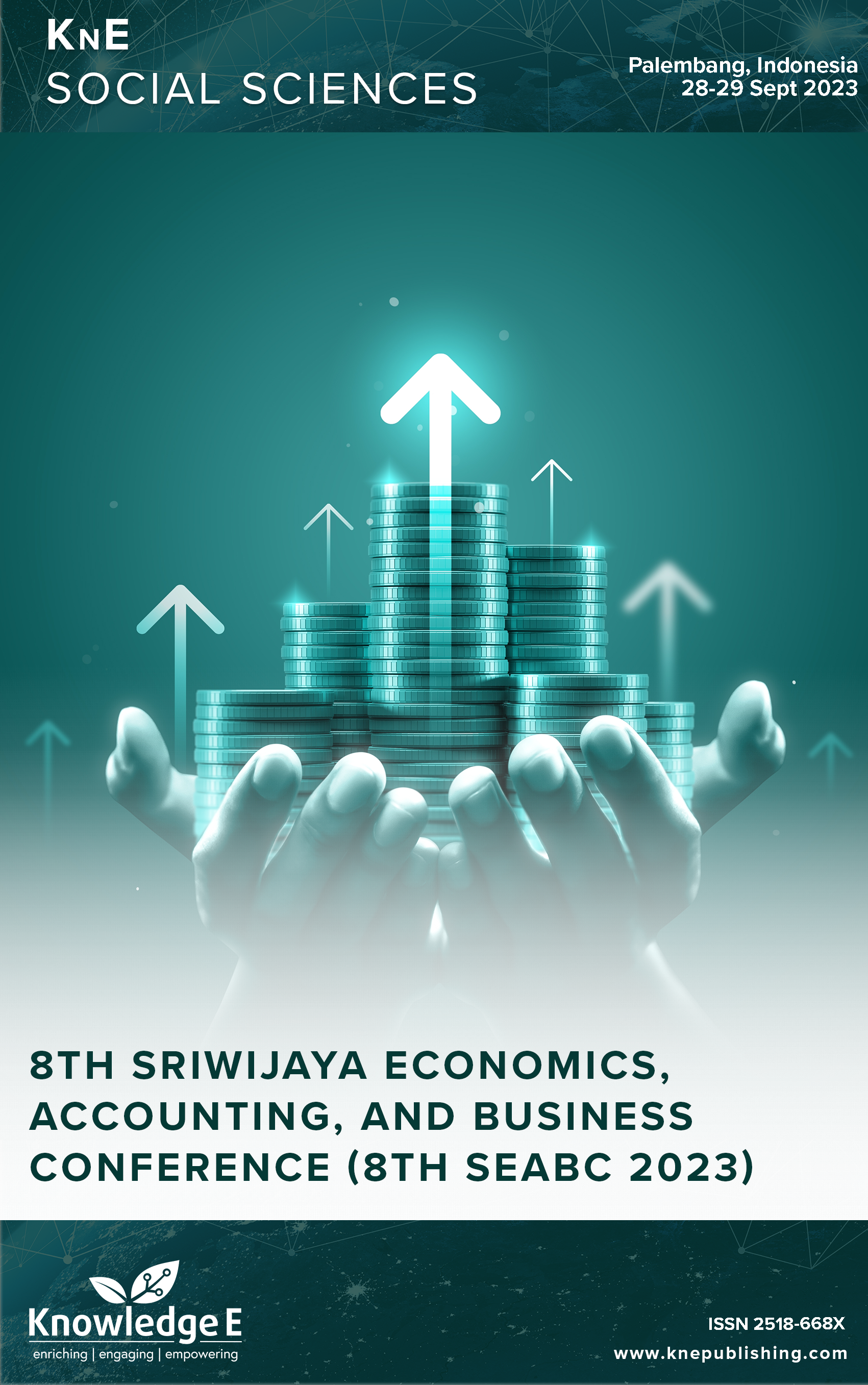Financial Development Shock and Foreign Direct Investment in Indonesia
DOI:
https://doi.org/10.18502/kss.v9i14.16100Abstract
This study analyzed the response of Foreign Direct Investment (FDI) due to the shock on financial development in Indonesia from January 2010 to December 2022. The variables used in this research are FDI and financial development, which measure financial development using traditional measurements such as the Amount of Money in Supply, Credit, and Market Capitalization. Interest Rate and Trade Openness Variables were used as control variables. The study used the VECM method. Results show that in response of the shock on financial development on FDI, Money Supply is positive, Credit negative, and Market Capitalization negative.
Keywords: foreign direct investment, financial development, money supply, credits, market capitalization
References
Huidrom R, Kose MA, Ohnsorge FL. How important are spillovers from major emerging markets? How important are spillovers from major emerg mark. Epub Ahead of Print; 2017. https://doi.org/10.1596/1813-9450-8093 DOI: https://doi.org/10.1596/1813-9450-8093
Report IM. Indicators of financial structure, development, and soundness. Indicators of financial structure, development, and soundness. 2005. pp. 15–33.
Raj M. Financial dependence and growth: Further evidence. Appl Econ Lett. 2009;16(3):325–330. DOI: https://doi.org/10.1080/13504850601018452
Millah RL, Wibowo W. The effect of financial development on economic growth countries Asean-4. Jurnal Ilmu Ekonomi Terapan. 2021;6(2):293. DOI: https://doi.org/10.20473/jiet.v6i2.29407
Demetriades PO, Hussein KA. Does financial development cause economic growth? Time-series evidence from 16 countries. J Dev Econ. 1996;51(2):387–411. DOI: https://doi.org/10.1016/S0304-3878(96)00421-X
Dang TT, Pham AD, Tran DN. Impact of monetary policy on private investment: Evidence from Vietnam’s provincial data. Economies. 2020;8(3):1–15. DOI: https://doi.org/10.3390/economies8030070
Kunanti NP, Adry MR. Analisis Pengaruh Financial Development Terhadap Pertumbuhan Ekonomi Di Indonesia. Jurnal Kajian Ekonomi Dan Pembangunan. 2020;2(1):43. DOI: https://doi.org/10.24036/jkep.v2i1.8857
Kong Q, Guo R, Wang Y, Sui X, Zhou S. Home-country environment and firms’ outward foreign direct investment decision: Evidence from Chinese firms. Econ Model. 2020;85:390–399. DOI: https://doi.org/10.1016/j.econmod.2019.11.014
Liu H, Islam MA, Khan MA, Hossain MI, Pervaiz K. Does financial deepening attract foreign direct investment? Fresh evidence from panel threshold analysis. Res Int Bus Finance. 2020;53:101198. DOI: https://doi.org/10.1016/j.ribaf.2020.101198
Osei MJ, Kim J. Foreign direct investment and economic growth: Is more financial development better? Econ Model. 2020;93:154–161. DOI: https://doi.org/10.1016/j.econmod.2020.07.009
Ang JB. Financial development and the FDI-growth nexus: the Malaysian experience. Appl Econ. 2009;41(13):1595–1601. DOI: https://doi.org/10.1080/00036840701222553
Shahbaz M, Topcu BA, Sar?gül SS, Vo XV. The effect of financial development on renewable energy demand: The case of developing countries. Renew Energy. 2021;178:1370–1380. DOI: https://doi.org/10.1016/j.renene.2021.06.121
Ersoy I. Ucinak financijske otvorenosti na financijski razvoj, rast i volatilnost u Turskoj: dokazi dobiveni ardl granicnim testovima. Ekon Istraz. 2011;24(3):33–44.
Desbordes R, Wei SJ. The effects of financial development on foreign direct investment. J Dev Econ. 2017;127:153–168. DOI: https://doi.org/10.1016/j.jdeveco.2017.02.008
Islam MA, Liu H, Khan MA, Islam MT, Sultanuzzaman MR. Does foreign direct investment deepen the financial system in southeast Asian economies? J Multinat Financ Manag. 2021;61:100682. DOI: https://doi.org/10.1016/j.mulfin.2021.100682
Contractor FJ, Nuruzzaman N, Dangol R, Raghunath S. How FDI inflows to emerging markets are influenced by country regulatory factors: An exploratory study. J Int Manage. 2021;27(1):100834. DOI: https://doi.org/10.1016/j.intman.2021.100834
Majeed A, Khan MA, Jiang P, et al. The impact of foreign direct investment on financial development: New evidence from panel cointegration and causality analysis. Journal of Competitiveness. 2021;13(1):95–112. DOI: https://doi.org/10.7441/joc.2021.01.06
Juniarti J, Christiawan YJ, Kwistianus H. Market response and future performance of inefficient investment: Over-investment or under-investment. Investment Management And Financial Innovations. 2022;19(4):146–159. DOI: https://doi.org/10.21511/imfi.19(4).2022.12
Syarkani Y. Pengaruh Market Size, Keterbukaan Pasar Dan Inflasi Terhadap Investasi Asing Langsung/Foreign Direct Investment (FDI) di Negara-Negara ASEAN. Jurnal Ilmiah MEA (Manajemen, Ekonomi, & Akuntansi). 2021; 5(3): 2827–2843. DOI: https://doi.org/10.24036/jkep.v3i3.12370
Barorah F, Malik N, Arifin Z. Analisis Investasi Asing Langsung (Fdi) Di Negara Asean Tahun 2000-2017. Jurnal Ilmu Ekonomi JIE. 2019;3(3):397–409. DOI: https://doi.org/10.22219/jie.v3i3.9036
Haque MA, Biqiong Z, Arshad MU. Sources of Financial Development and Their Impact on FDI Inflow: A Panel Data Analysis of Middle-Income Economies. Economies. 2022;10(8):182. Epub ahead of print. DOI: https://doi.org/10.3390/economies10080182
Nusantara A, Santosa AB, Nawatmi S. Adakah Peran Penting Pasar Domestik Dalam Mendorong Investasi Asing? 2018. pp. 978–979.
Anwar CJ, Okot N, Suhendra I, et al. Response of exchange rate to monetary policy shocks: An evidence from Indonesia. International Journal of Economics and Finance Studies. 2022;14(1):443–446.
Mankiw. Makroekonomi. Erlangga; 2018.
Salvatore D. Ekonomi Internasional (Edisi 9). Salemba Empat; 2014.

